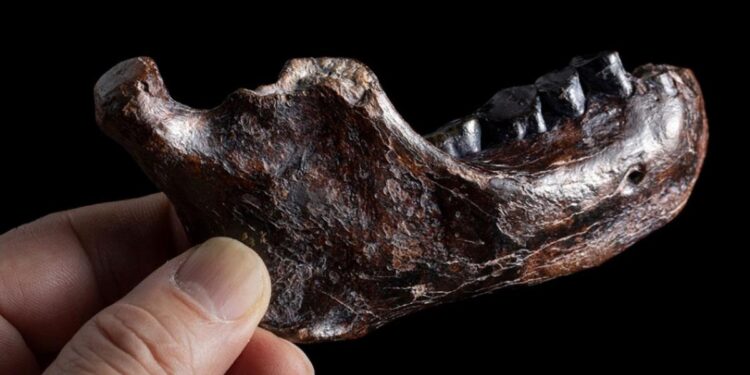A remarkable discovery has shed new light on prehistoric life, as scientists reveal a 200 million-year-old jawbone belonging to an entirely new species. Unearthed during recent excavations, the fossil offers fresh insights into the evolution of early vertebrates, challenging previous understandings of ancient ecosystems. The finding, reported by the BBC, marks a significant milestone in paleontology, opening new avenues for research into the distant past.
Ancient Jawbone Discovery Sheds Light on Prehistoric Evolutionary Pathways
Unearthed in a remote sedimentary basin, this remarkably preserved jawbone, estimated to be around 200 million years old, has been identified as belonging to a previously unknown species. Paleontologists have hailed this discovery as a breakthrough in understanding early vertebrate evolution, revealing intricate dental structures that challenge existing timelines of mammalian lineage development. The fossil exhibits a unique combination of traits, bridging a crucial gap between ancient reptilian ancestors and the first true mammals.
Among the notable features of this specimen are:
- Complex tooth differentiation: incisors, canines, and molars present in a sophisticated arrangement.
- Robust jaw articulation: suggesting advanced chewing capabilities previously undocumented in this era.
- Micro-wear patterns: indicating a diverse diet rather than simple herbivory or carnivory.
| Feature | Significance |
|---|---|
| Tooth morphology | Signals early specialization of feeding habits |
| Jawbone robustness | Indicates stronger bite forces than contemporaneous species |
| Age estimation | Redefines the timeline of synapsid evolution |
New Species Identification Challenges Existing Fossil Records and Classification
The discovery of a 200 million year-old jawbone has disrupted the current understanding of prehistoric life, prompting paleontologists to reconsider established classification frameworks. Unearthed in a remote excavation site, this fossil exhibits unique anatomical features that diverge significantly from known species of the Triassic period. Researchers are particularly intrigued by the bone’s dental arrangement and jaw articulation, which suggest a lineage previously undocumented in the fossil record. These findings challenge the assumption that the evolutionary path of early reptiles was more linear and highlight the complexity of life forms thriving in ancient ecosystems.
This breakthrough has sparked a new wave of scientific debates with implications for taxonomy and evolutionary biology. Key points of interest include:
- Distinctive dentition: Features that do not align with existing reptilian groups.
- Chronological significance: Dates back to early Jurassic, filling gaps in fossil timelines.
- Geographical distribution: Found outside previously documented habitats for similar species.
To put this into perspective, here is a comparison of jawbone traits between the new species and closely related fossil finds:
| Trait | New Species | Known Species A | Known Species B |
|---|---|---|---|
| Dental Count | 28 | 22 | 24 |
| Jaw Length (cm) | 15 | 12 | 14 |
| Articulation Type | Unique pivot joint | Hinge joint | Hinge joint |
These significant deviations underscore the necessity for a revised framework in interpreting early vertebrate evolution.
Experts Urge Expanded Excavations to Uncover Further Evidence of Early Vertebrates
Following the discovery of a 200 million-year-old jawbone, paleontologists are calling for a significant expansion of excavations in sites rich with early vertebrate fossils. Experts argue that the newly identified species offers a critical window into vertebrate evolution during the Triassic period, a time marked by rapid diversification. Intensive digs, combined with state-of-the-art imaging technology, could unearth more specimens that refine our understanding of the ecosystem dynamics and evolutionary pathways of early jawed vertebrates.
The research community has outlined key areas where excavation efforts should be intensified, emphasizing the potential for groundbreaking discoveries. Early vertebrate fossils are often found in sedimentary rock layers that have yet to be fully explored, and expanding fieldwork could yield:
- Better preservation of skeletal structures, enabling precise taxonomic classification
- New species identification that fill evolutionary gaps
- Insights into paleoenvironmental conditions and their influence on vertebrate adaptation
| Site | Estimated Age (MYA) | Fossil Type | Excavation Status | ||||||||
|---|---|---|---|---|---|---|---|---|---|---|---|
| Northern Basin | 205 | Jaw fragments, teeth | Ongoing | ||||||||
| Eastern Cliffs |
Following the discovery of a 200 million-year-old jawbone, paleontologists are calling for a significant expansion of excavations in sites rich with early vertebrate fossils. Experts argue that the newly identified species offers a critical window into vertebrate evolution during the Triassic period, a time marked by rapid diversification. Intensive digs, combined with state-of-the-art imaging technology, could unearth more specimens that refine our understanding of the ecosystem dynamics and evolutionary pathways of early jawed vertebrates. The research community has outlined key areas where excavation efforts should be intensified, emphasizing the potential for groundbreaking discoveries. Early vertebrate fossils are often found in sedimentary rock layers that have yet to be fully explored, and expanding fieldwork could yield:
|































